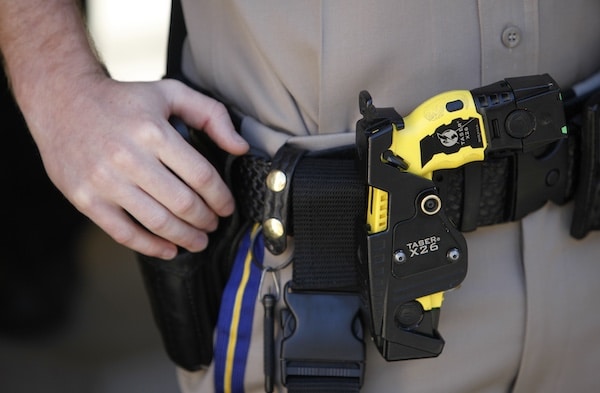A poof of white smoke clouds the main entrance of my cellblock as electric shocks jolt through my body. I buckle and smack the ground faster than expected. The two other prisoners I was fighting use the opportunity to strike me, until correctional officers tackle them down.
I am then transferred to segregation after a visit to the medical unit. While I’m thankful for not losing my teeth from the impact, I keep asking myself the same question: Why was I tased first when I was protecting myself from being attacked by two other prisoners?
When I was incarcerated by the Michigan Department of Corrections (MDOC) in 2010, tasers were not used inside correctional facilities. But beginning in early 2012, MDOC had a statewide program that allowed correctional officers to use these devices against the incarcerated population. In 2020, under the pressure of the COVID-19 lockdowns, altercations between incarcerated people increased—and so did the use of tasers by correctional officers. Tasers have opened the door to more unnecessary force being used against the prison population, along with added psychological trauma and deaths among prisoners.
The use of tasers isn’t unique to Michigan prisons. A 2017 report by Reuters found hundreds of examples of tasers being misused throughout U.S. prisons, with 104 deaths between 2000 and 2017 linked to tasers.
In 2013, one year after Michigan introduced tasers into its prisons, MDOC credited the weapon with a drop in attacks against staff. Activists began ringing alarm bells. “The potential for abuse is just too great. I think you are going to have guards that are trigger-happy with the tasers,” Kay Perry, executive director of Michigan CURE, told Corrections1 at the time.
They require a great deal of judgment. My bottom line is to get them out of there.
Three years later, Perry’s fears came true. In 2016, Michigan correctional officers killed Duston Szot by shocking him with a taser as they tried to break up a fight.
At the time, Szot was fighting with another prisoner. From my own perspective while incarcerated, the attacks always involved prisoners fighting each other—not intentional assaults against staff.
On a Michigan prison yard, men fight due to mental illness, for food items or over disrespectful words and name calling, and a fight may be more likely to break out if someone is drunk on toilet wine or high on medication. A fight normally ends with a correctional officer—or group of correctional officers—running full speed onto the yard to tackle the prisoner or prisoners mid battle. The fighters are cuffed, out of breath, and hauled off to a cell—leading to a twenty-four-hour lockdown for the people who fought.
During the fights, many of us stand at a safe distance watching and waiting to see how a correctional officer chooses to gain control with their taser. The officer might have to choose between which prisoners to tase, evaluating on the fly which one is more uncontrollable when they are both brutally fighting for their lives.
Most officers don’t call out “stop fighting” or “taser.” The taser is often used by correctional officers as a “surprise attack.” These mishaps are then documented as attacks against staff.
Since the pandemic, I’ve seen tension between staff and prisoners, as well as violence, increase. The main reason for this is worsening prison conditions, including the lack of showers and phone use, the onslaught of insults and brutality from staff, the lack of family visitation options, and consistent punishment for being sick.
After one electrical shock from a taser, the human body stiffens before falling forward wherever the prisoner is standing. The weapon’s embedded dart electrodes deliver 50,000 Volts and 26 Amps to the human body on contact. I have witnessed a row of teeth scattered on the floor, a damaged eyeball from the device, and an overuse of the amount of electricity administered to a prisoner.
The tasers used in Michigan prisons have a built-in camera and begin to record as soon as it’s activated. Prison cameras aren’t like street cameras where you can show evidence after the fact. Here, footage of possible mishandling of the ECD device often disappears—there is some error to retrieve any footage that shows officials in any wrongdoing.
While police use of tasers in the outside world has been under increased scrutiny, the shroud of secrecy around their use in prisons has resulted in limited outcry and advocacy. Still, people across U.S. prisons are increasingly vulnerable. In the past year, a Kentucky correctional officer was fired for tasing prisoners who failed drug tests, while taser-related lawsuits were filed against officers in New York and Texas.
Axon Inc., a $6 billion company that supplies police and correctional officers with body cameras and tasers, has recently ramped up sales around the world. This March, the United Kingdom started a trial period that could potentially deploy tasers to correctional officers there as well.
In my own experience—after footage of brutality gets lost or discarded—things go back to “normal.” In reality, it’s anything but normal. Across Michigan prisons, no one is being held accountable for their carelessness with these life-threatening devices.
Demetrius Buckley is the winner of the 2021 Toi Derricotte & Cornelius Eady Chapbook Prize, and his work has appeared or is forthcoming in The Rumpus, Pen America, Scalawag, Tahoma Review, The Offing, Southern Review, and elsewhere.

